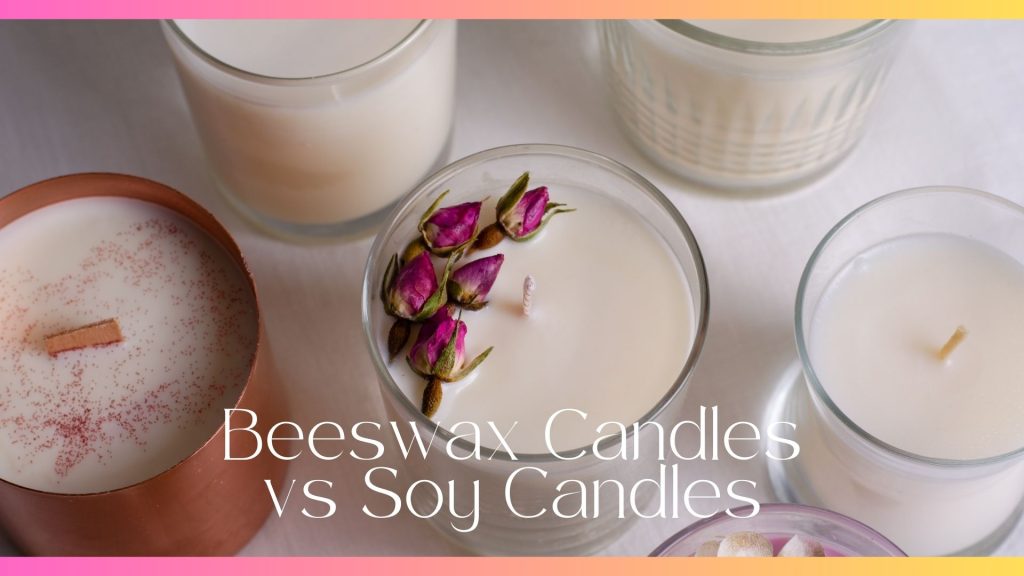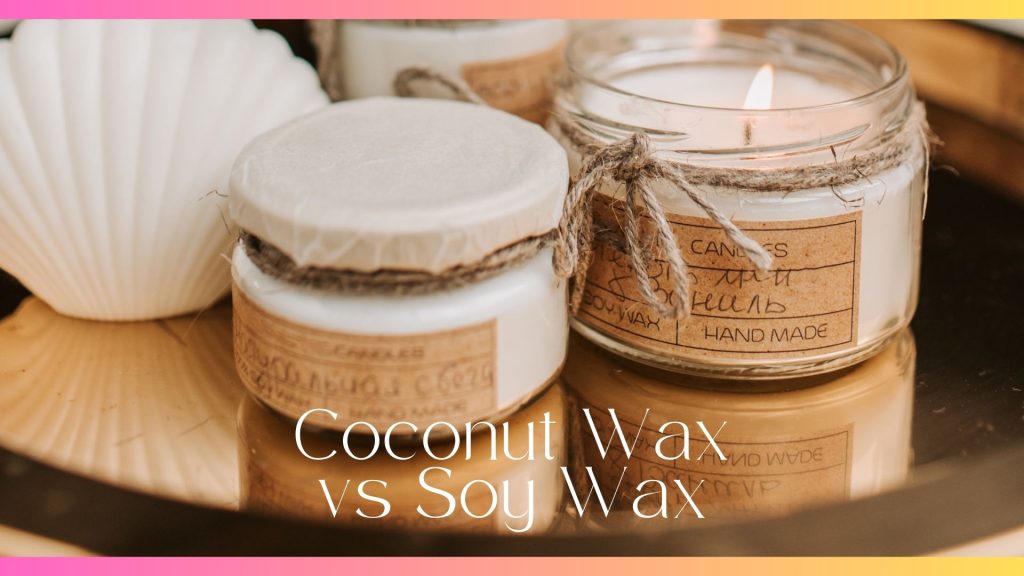Unsure what is the best wick for coconut wax candles? It’s definitely a big thing to decide on as wicks affect your candle’s burning performance.
What works for one person may not work for another and vice versa – that’s just the same wick candle wicks!
In this article, I’ll discuss the best wicks you can use for making your coconut wax candles and what makes them a good option for candle-making.
Disclaimer: This post may contain affiliate links. This means I may earn a small commission (at no cost to you) if you sign up for a program or make a purchase using my link!
Related Posts:
- Soy Candles vs Coconut Candles for Candle-making
- How To Make Coconut Wax Candles with Essential Oils
- How Long Do Coconut Wax Candles Need To Cure?
Why Use Coconut Wax?
If you’re new to candle-making, you’ve probably heard of soy wax, paraffin wax and beeswax the most. There’s a growing trend for coconut wax but it’s less used due to the higher prices and limited availability.
Similar to a few other waxes, coconut wax is naturally made from hydrogenated coconut oil (that’s derived from coconut or the fruit of a coconut tree). It’s used in candle-making today as it is a sustainable and biodegradable wax alternative compared to paraffin, but offers a comparable strong scent throw.
Apart from burning cleaner and longer, coconut wax also gives a smooth creamy texture to your final candle product. Some candle-makers may also find it practical to add coconut oil to their soy wax (instead of using coconut wax) as it gives almost the similar results.
Importance of Choosing the Right Wick
Candle-making isn’t as straightforward as it looks for most and choosing the right wick is actually important to ensure optimal candle burning performance.
The wick that you use for your candles control how your candle burns. It impacts the flame size, burn rate, and how evenly the wax melts. These would also determine whether your candles are good and if they are safe for use of others.
Aside from choosing a wick based on its length, you’ll have to consider the wick’s thickness or “size”. Generally, a wider candle diameter would require a thicker wick and a narrower candle will need a thinner wick. The best wick length should depend on the height or tallness of the candle wax and/or container being used.
When selecting a wick, you will have to consider the wax type, candle size, fragrance load, and desired burn characteristics.
3 Types of Wicks for Coconut Wax Candles
There are several types of wicks that work well with coconut wax, each with its own set of benefits.
If you’re a new candle-maker, I would suggest sticking to sustainable wick options from the start to make your candles eco-friendly. You can choose between organic cotton wicks that are free from pesticides and chemicals or eco-friendly wooden wicks that are sourced from sustainable wood.
For most coconut wax candles, a high-quality cotton wick provides the best balance of performance and ease of use. If you’re looking for an affordable option, standard cotton wicks are cost-effective and widely available.
Here are three types of wicks commonly used for coconut wax candles.
- Cotton wicks: Easy to source and use, they provide a consistent flame and are suitable for most candle types. Cotton wicks can sometimes produce mushrooming (carbon build-up) and may require regular trimming to maintain optimal performance.
- Wooden wicks: They create a soothing crackling sound and have a modern, aesthetic appeal. Wooden wicks also tend to burn more evenly but can be harder to light and maintain. You may also need to use a larger (wider) wooden wick to produce an adequate flame.
- Coreless wicks: Coreless wicks, such as braided cotton, reduces mushrooming, provides a consistent burn and are less likely to produce soot. They can be more challenging to work with for beginners, as they require precise trimming and positioning.
Best Practices for Wick Selection
With enough experiment and experience, you’ll be able to choose the right wick easily. As a start, just try your best to match the wick size to the diameter of your candle.
A larger candle requires a thicker wick to ensure an even burn and a smaller candle would need a thinner wick, vice versa. However, what works for one candle may not work for another and there’s just so many types of wicks in the world!
It’s best to always test different wicks with your specific candle formulation to achieve the best results. Adjust wick size and type based on how your candle burns. If it tunnels, use a thicker wick and if it mushrooms, try a thinner wick.
Here are three common challenges you may face when trying to find the best wicks for your coconut candles.
- Tunneling: This occurs when the candle burns down the middle, leaving wax on the sides. Try a thicker wick and/or allow the candle to burn longer during each use to achieve a full “melt pool”.
- Wick Mushrooming: Mushrooming is the build-up of carbon on the wick causing it to be black and slightly thicker than what it should be. Regular trimming can help prevent this and make sure to trim wick to 1/4 inch before each use.
- Uneven Burning: This may be due to an improperly sized wick that’s not the correct size for your candle diameter. For a candle jar, the shape and size of the jar will also affect burning performance.
Enhancing Candle Performance
To enhance the performance of your coconut wax candles, regularly trim your wick to about 1/4 inch to ensure a clean, even burn. This is true for whatever kind of wick you’re using, whether it’s a cotton or wooden wick.
You should also allow your candle to burn long enough the first time around for the entire surface to melt (a full melt pool). This helps prevent tunneling that usually happens with subsequent uses and extends the candle’s life.
If you’re a candle-maker looking to sell your handmade candles, be sure to include these guidelines in your candle care card. Not everyone knows how to use their candles properly!
Read: How to care for your candles the right way
Bottom Line
Choosing the right wick for your coconut wax candles is a very important step in the candle-making process. The types of wicks used for your candles can significantly impact their burning performance and your overall experience.
With every unique product, it’s best to test out what works for you and your candles. There’s just so many wicks to choose from in the market and not all are the same. The general guideline I’ve provided above should give you a good first understanding on the importance of wicks and benefits of different wicks.
Go and create beautiful, long-lasting candles that burn evenly and release delightful fragrances!
Frequently Asked Questions (FAQs)
The best wick for coconut wax is typically a cotton wick with a sturdy core, such as a cotton-paper or cotton-braided wick. These wicks provide a stable burn that complements the clean-burning properties of coconut wax. Cotton wicks are known for their ability to burn steadily and evenly, ensuring a consistent flame and reducing the risk of tunneling. They are also effective in maintaining a strong scent throw, which is a key advantage of coconut wax. When selecting a wick, it’s crucial to consider the diameter of your candle; larger candles may require thicker or multiple wicks to ensure proper burning. Testing different wick sizes and types is essential to find the perfect match for your specific coconut wax blend and candle size.
You can use Eco wicks for coconut wax candles. Eco wicks are made from natural flat cotton threads interwoven with paper threads, which help them burn cleanly and steadily. These wicks are particularly suitable for coconut wax due to their ability to provide a consistent burn, minimizing soot and smoke. Eco wicks are designed to be self-trimming, meaning they create a smaller, controlled flame that reduces mushrooming (the build-up of carbon on the wick tip). This feature enhances the overall burning experience and maintains the candle’s appearance. When using Eco wicks with coconut wax, it’s essential to test different sizes to find the right balance between wick thickness and candle diameter, ensuring an even melt pool and maximizing the scent throw.
Wooden wicks are good for coconut wax candles and can add a unique touch to your candle-making projects. Wooden wicks create a soothing crackling sound reminiscent of a fireplace, enhancing the ambiance and sensory experience. They also burn cleanly and evenly, complementing the characteristics of coconut wax. However, it’s important to choose the right size and type of wooden wick for your coconut wax candles. Wooden wicks come in various thicknesses and widths, and finding the perfect match ensures a proper burn without excessive flickering or extinguishing. Testing is crucial to determine the ideal wick for your specific candle size and wax blend.
For coconut apricot wax, wicks that work well include cotton-braided wicks, Eco wicks, and wooden wicks. Cotton-braided wicks provide a reliable, consistent burn and enhance the wax’s natural clean-burning properties. Eco wicks, made from natural cotton and paper, are also an excellent choice due to their steady burn and minimal soot production. They help maintain a strong scent throw, which is a key benefit of coconut apricot wax. Wooden wicks can also be used, adding a unique visual and auditory experience with their crackling sound. When choosing a wick for coconut apricot wax, it’s essential to test different sizes and types to achieve the optimal flame size, burn rate, and scent throw.


